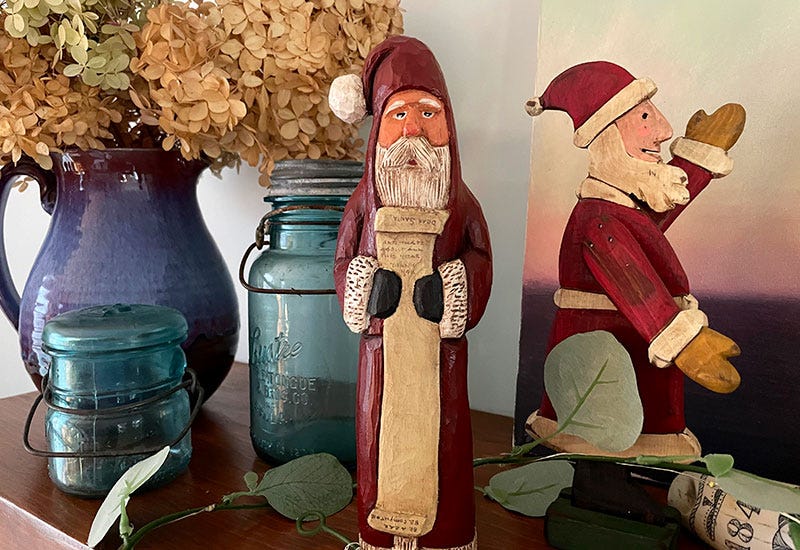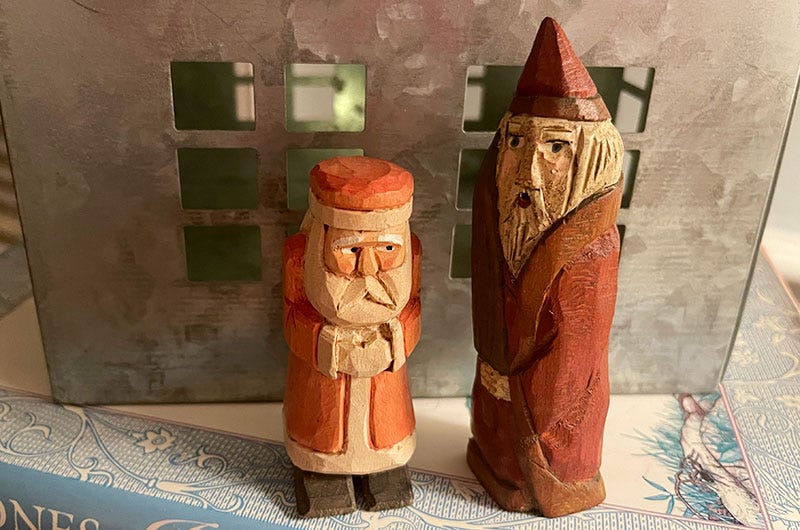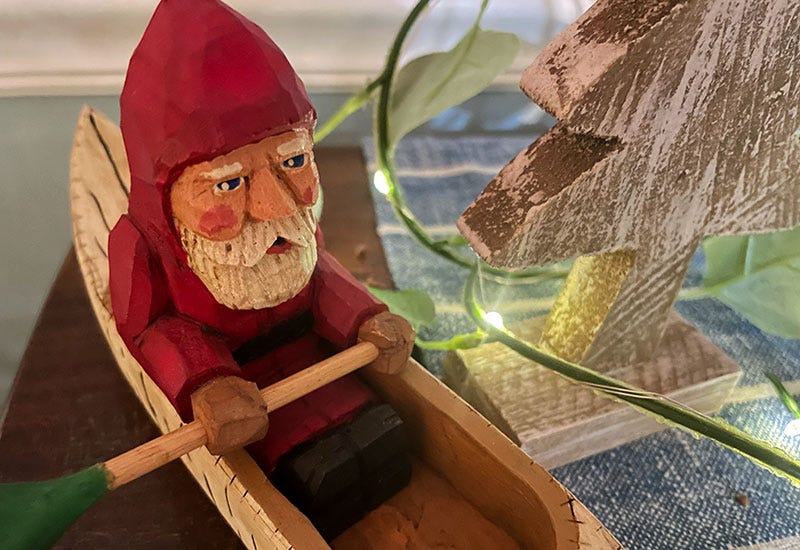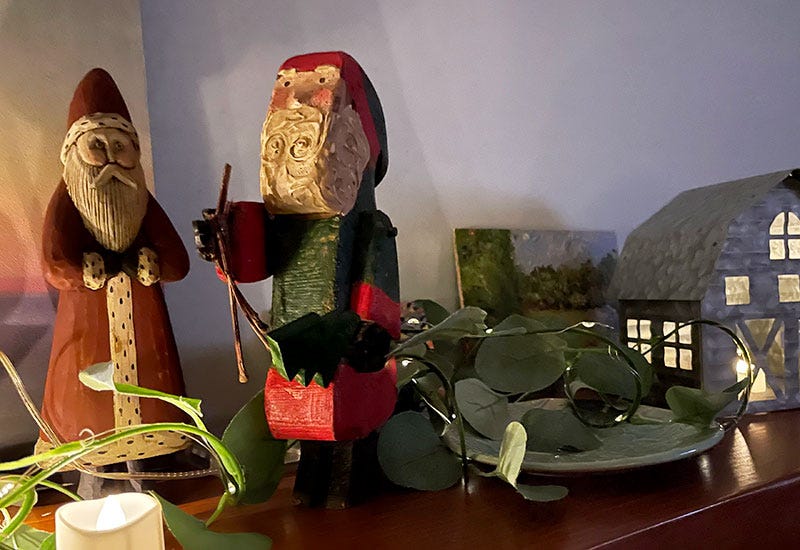I open a box of Christmas decorations and my mother pops out. I throw the lid back on the box, but it’s too late. I’ve let the genie out of the bottle. She – and my complicated relationship with her – is right here.
It’s like I summoned her. I made her molasses crinkles cookies this morning, her pumpkin bread last week. Now here I am unwrapping the wooden Santas, carefully folding up the faded tissues they’ve been wrapped in, year after year.
Or maybe I haven’t so much conjured her into my present as I have climbed into the backseat of the station wagon of my past, riding along with her in a way that can’t be described as a memory. It is more visceral than that, this presence of my mother at Christmastime.
I wonder why, when people close to you die, they leave you with a suitcase of desire, a longing to unpack the thing that was your relationship to them, over and over ‑ but only when the suitcase is popped open; much of the time it lives in the back of the closet, filling the space under the eaves that won’t fit much else.
She was a 12-kinds-of-cookies holiday baker, this mother of mine. She started weeks in advance and froze each different kind, neatly labeled, and then pulled out a selection —shortbread, Swedish tea cakes, Snickerdoodles — each time she went visiting a friend. Visiting is something housewives used to do back in the day. But during the holidays it took on the rhythm of a ritual, a circuit of cookie-delivering mavens moving from house to house like partners in a country line dance.
Sometimes I went with her on these afternoon visits. My hair combed, my knee socks pulled up straight, my pleases and thank yous at the ready. It always spooked and confused me a little to be in the intimate spaces of other people’s living rooms at Christmastime. Their trees were different from ours – artificial instead of real, or white pine instead of blue spruce. One on top of a table! They had bushy gold tinsel garlands and lots of shiny balls; we had icy silver threads of tinsel and wooden ornaments. They had knitted stockings; ours were felt. They had electric trains or giant nativity scenes. We had poinsettias and boxwood wreaths.
Glued to my mother like a fly to sticky paper, I watched her and learned the art of conversation, the nuances of timing (arriving and departing in a neat 15-minute time frame), the flirtatious act of fostering friendships.
She was good at this friends thing. That’s how she survived a childhood living with an alcoholic mother. It’s how she learned to present an extroverted narrative of abundance and propriety as a cover for the inseparable twins of anxiety and fear. It’s how she internalized the crippling necessity of maintaining appearances – and passed it on to her daughters.
In later years, after the tumult of puberty had cracked the foundation of mother-daughter love, after my sister and I had thoroughly imbibed the anxiety and formed our own maladaptive behaviors to deal with it, Christmas turned into a festive disaster. Everybody still dressed up. My Dad still made popovers and Bloody Marys on Christmas morning (yes, there is never an occasion, including the birth of Jesus, that we can’t drink to in our family), we opened the stockings my mother worked so hard to fill, and inevitably, discord or drama followed. Or we were recovering from whatever disagreement or disappointment had happened Christmas Eve.
But this isn’t the Christmas I’m thinking about as I’m unwrapping my mother’s beloved collection of wooden Santas.
Actually, I only have some of the Santas. My sister – who stood at a distance even further from my mother for many years, who suffered even more than I did from the Christmas maelstrom – not only has the bulk of the Santa collection, displayed on her sideboard, but she has seemingly morphed into my mother when it comes to Christmas. Her house is decorated colorfully and tastefully. She has the perfect cocktail napkins and highball glasses. Her tree is even more gorgeous than anything we had growing up, because my sister has the eye and skills of an artist and the style of an interior decorator. She is the one who sewed our matching Christmas outfits when we were growing up.
Since neither my sister nor I had children, and my father is still alive, we reenact the traditions of our family Christmas as if nothing has changed in 60 years. My sister has appointed herself Mom, filling the stockings, making sure there are equal amounts of presents for everyone under the tree. Cooking the rib roast. Buying the Christmas Crackers. But fortunately, there is no drama on the menu or under the tree.
This idealized version of Christmas is the one that my sister and I have chosen to perpetuate. It’s the one my mother, despite (or because of) her childhood, tried so hard to give us — the cookies, the Advent calendars, the trips to see The Nutcracker, the Christmas Eve table set like a feast at Downton Abbey.
But as I arrange the Santas on my mantel, I am melancholy. I just feel my mother’s presence so acutely. It’s a loving presence. She isn’t angry or anxious. But she is in a place I can’t reach her, and all I can think about is that I will never be able to reconcile how things were once and how things became and what never got resolved. While she was living, I wasn’t capable of fully understanding her. And truthfully, in the five years since her death, that hasn’t changed.
It would be nice to imagine the tidy resolutions that might have been. It would be nice to think that I might have been kinder and more compassionate to her in times when she was really hurting but all I could do was back away from what felt like a hot blaze of anxiety. But life doesn’t work like that. People – especially two people bound in blood and love — do their best. I tried and so did she.
I think this is why the holidays are so emotional for all of us – we are simultaneously reminded of love and hurt, of desire and disappointment, of our generous impulses and our inevitable limitations. It is a relief when the genie goes back in the bottle – and the Santas go back in the box.
🎅🏼
Recipe Links + Big News:
The Cook the Vineyard Newsletter is Now on Substack!
First: In case you need the recipes for Big Molasses Crinkles, Pumpkin-Ginger Quickbread, or Popovers, they’re all on cookthevineyard.com. (I am fond of updating my childhood recipes – maybe another attempt to rewrite history?!)
Second, and very exciting: The Cook the Vineyard newsletter, as of this week, has migrated to Substack.
Many of you know that I edit this newsletter as part of my day job for the Vineyard Gazette Media Group. It’s a high-value publication, packed with content — almost like a mini-magazine. Filled with recipes, photos, tips, techniques, and food news, the newsletter celebrates eating and cooking with the seasons.
We have thousands of subscribers not only on Martha’s Vineyard but around the country and the globe. Here on Substack we are offering two options: a paid weekly newsletter (with extra benefits, including chats and Q&As) or a free monthly edition. It’s a labor-intensive (in the labor-of-love vein) publication to edit (and to develop recipes for), so I feel that having a paid edition is the right thing to do. I also am proud of the fact that the publications I edit at the Vineyard Gazette Media Group help support our 177-year-old newspaper, the Vineyard Gazette.
The first Substack version of the newsletter (actually edition 232) will go out this Wednesday, Dec. 20. The next two newsletters after that will be free, and the paid newsletter will begin going out on Wednesday, Jan. 10. If you like to cook with the seasons, I’d love it if you’d subscribe. Or if you’re already a free subscriber, I encourage you to upgrade to paid so that you don’t miss an issue.










I’m sitting here having read this with tears in my eyes. We try and try to reconcile over the transom of time and memory, and the only place where things change is in our hearts before we’re snapped like a rubberband into anxiety. Such gorgeous writing. 🙏🏻
Only Love Prevails.
I can’t bring them back again
Those moments I hold fast in memory
Dear ones dancing in my dreams
Still reaching out to me
When Spring has come and gone again
And brilliant Summer pales
And Fall sets sail in frosty winds
Only love prevails
No, I can’t change the flow of time
Tho sometimes I’ve wished that I could
But my heart shall bind up all loose ends
And keep them mine for good
So let us recall some old songs
And sing them out around the fire
And hail once more our loved ones before
The hour that we retire
When Spring has come and gone again
And brilliant Summer pales
And Fall sets sail in frosty winds
Only love prevails
Malcolm McKinney 2016